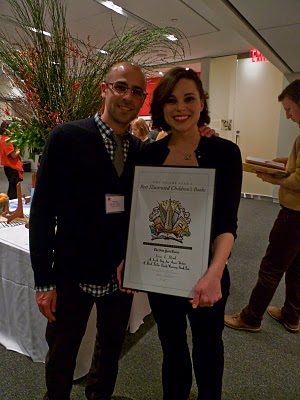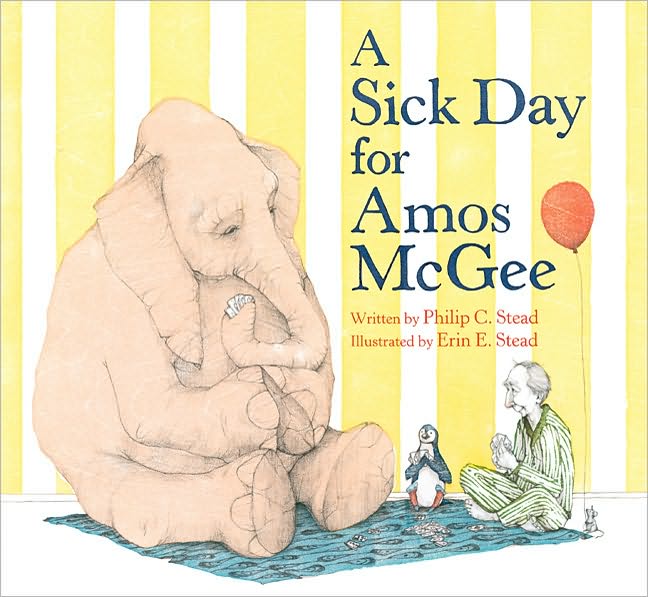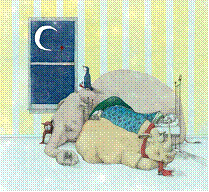 A Sick Day for Amos McGee, winner of the 2011 Caldecott Medal, is the story of a zookeeper who tends
to the animals in his care in unorthodox ways; when he stays home sick, the
animals come to his house and tend to him. Erin Stead illustrated it. Philip
Stead, her husband, wrote the manuscript for her. Recently, they moved from a
cozy space in Brooklyn, N.Y., to a 100-year-old farmhouse in their native Michigan.
But their studio is still a cozy place. Here Erin Stead talks about how she
works with Philip and how she approaches her art.
A Sick Day for Amos McGee, winner of the 2011 Caldecott Medal, is the story of a zookeeper who tends
to the animals in his care in unorthodox ways; when he stays home sick, the
animals come to his house and tend to him. Erin Stead illustrated it. Philip
Stead, her husband, wrote the manuscript for her. Recently, they moved from a
cozy space in Brooklyn, N.Y., to a 100-year-old farmhouse in their native Michigan.
But their studio is still a cozy place. Here Erin Stead talks about how she
works with Philip and how she approaches her art.
Where did this idea come from? Did it begin with one of you and spill over to the other?
Phil wrote the story for me, unbeknownst to me at the time. Usually I won't necessarily hear about his stories until he feels like they're a little less abstract. I'm usually the first to see them. He wrote it knowing better than I did what I draw well. He thought I could do the relationship between animals and people.
 Since you and Philip
are both artists, do you confer on what the illustration might look like? Or is
it more like traditional writer-artist situations, and Philip gave you the
manuscript and said, "Go!"?
Since you and Philip
are both artists, do you confer on what the illustration might look like? Or is
it more like traditional writer-artist situations, and Philip gave you the
manuscript and said, "Go!"?
He definitely gave me the manuscript and said, "Go," and I was the one who walked around with the characters in my head for a long time, and got to know who they were and what they looked like, and put them through my first character sketches. He's my first critic, and nothing goes out without his approval. He definitely let me do whatever I wanted and didn't art direct me in any way. Because he's a visual person, he could see what I would maybe illustrate. The only time we passed things back and forth was when I was struggling, like when I did the rhinoceros. It was probably fine, but I kept drawing something that I thought leaned more toward cow. So he drew a little rhinoceros for me. That's when it broke through for me. We're able to do things like that for each other. We share work space so we're constantly looking over each others' shoulders, so it's like a constant dialogue throughout the day or year--however long it takes to get the picture right.
From the picture on your blog, it looks like you have easels right next to each other. So you do have a constant dialogue throughout the day?
We do chat throughout the day, and sometimes it's silly. If things are going well, it's like two kids in a treehouse, and if things aren't going well, then it's different. But usually if one of us is having a bad day, the other isn't. When I was making Amos, we were sitting in a really tiny room together [in Brooklyn], and if I didn't straighten my elbow, I'd touch Phil.
We know from Philip's book Creamed Tuna Fish and Peas on Toast that his family hails from the Dearborn area, a stone's throw from Ann Arbor. Do you also have ties to Michigan?
I grew up there, and then we lived in New York for a while. Phil was working at the Brooklyn Children's Museum. We met in high school in Dearborn. I feel like everyone in children's books is from Michigan. Where is everybody else going? [Full disclosure: this editor grew up in Kalamazoo, Mich., as did Betsy Bird, Fuse #8.]
 Can you describe your
process of working with woodcuts? Your line is so delicate!
Can you describe your
process of working with woodcuts? Your line is so delicate!
The line is pencil, so don't be impressed. If you really go back in my blog, the first post is about the process. There are multiple steps. All of the color is applied with woodblock. I sketch out the illustrations beforehand, apply the color, wait for it to dry, and then draw the picture. The woodblock is all flat color and then I draw on top of the color.
What are you working on now?
I just finished a fall book that Phil didn't write, which will be out next winter. Right now I'm working on a book that Phil did write, which is due in fall 2012.

